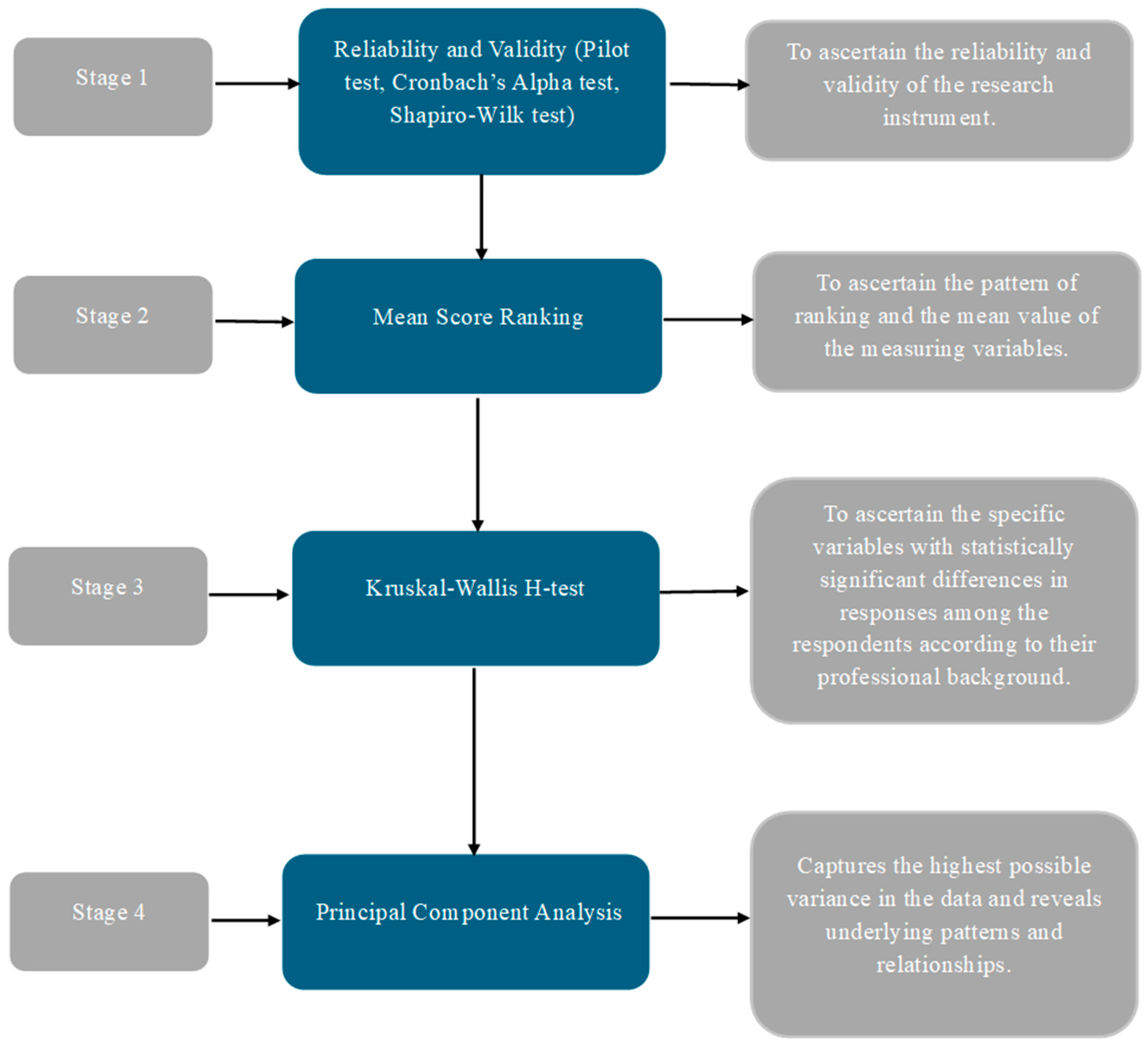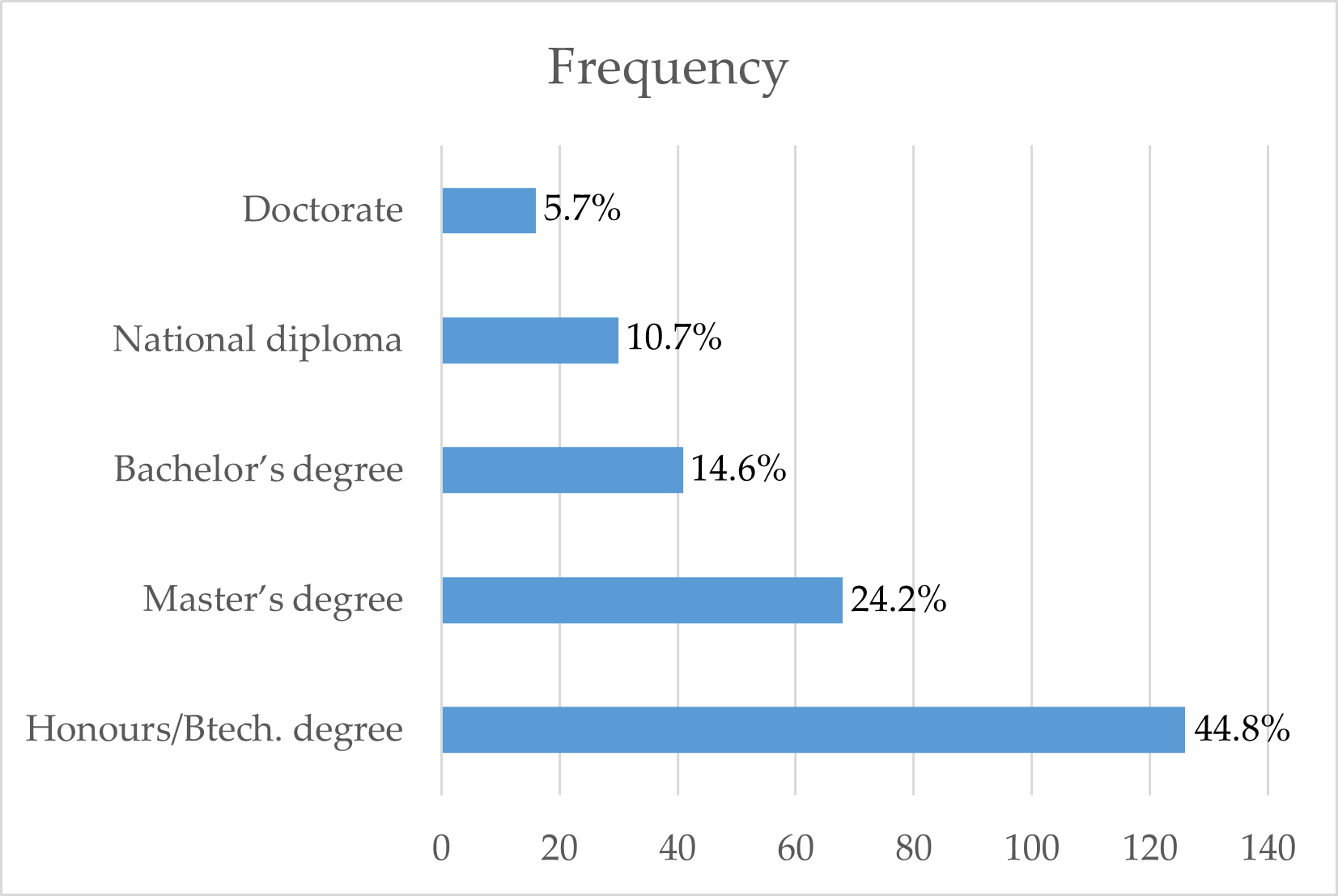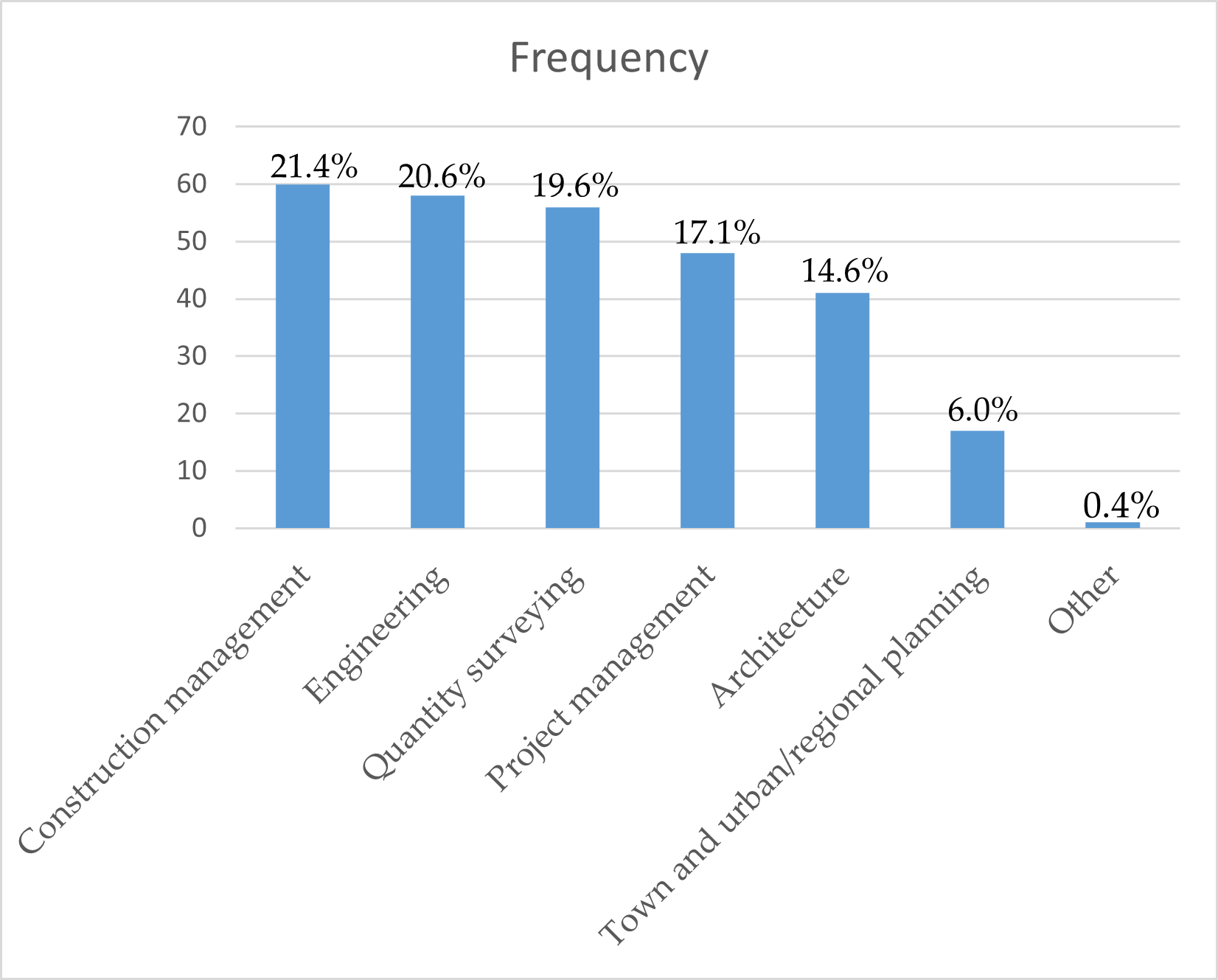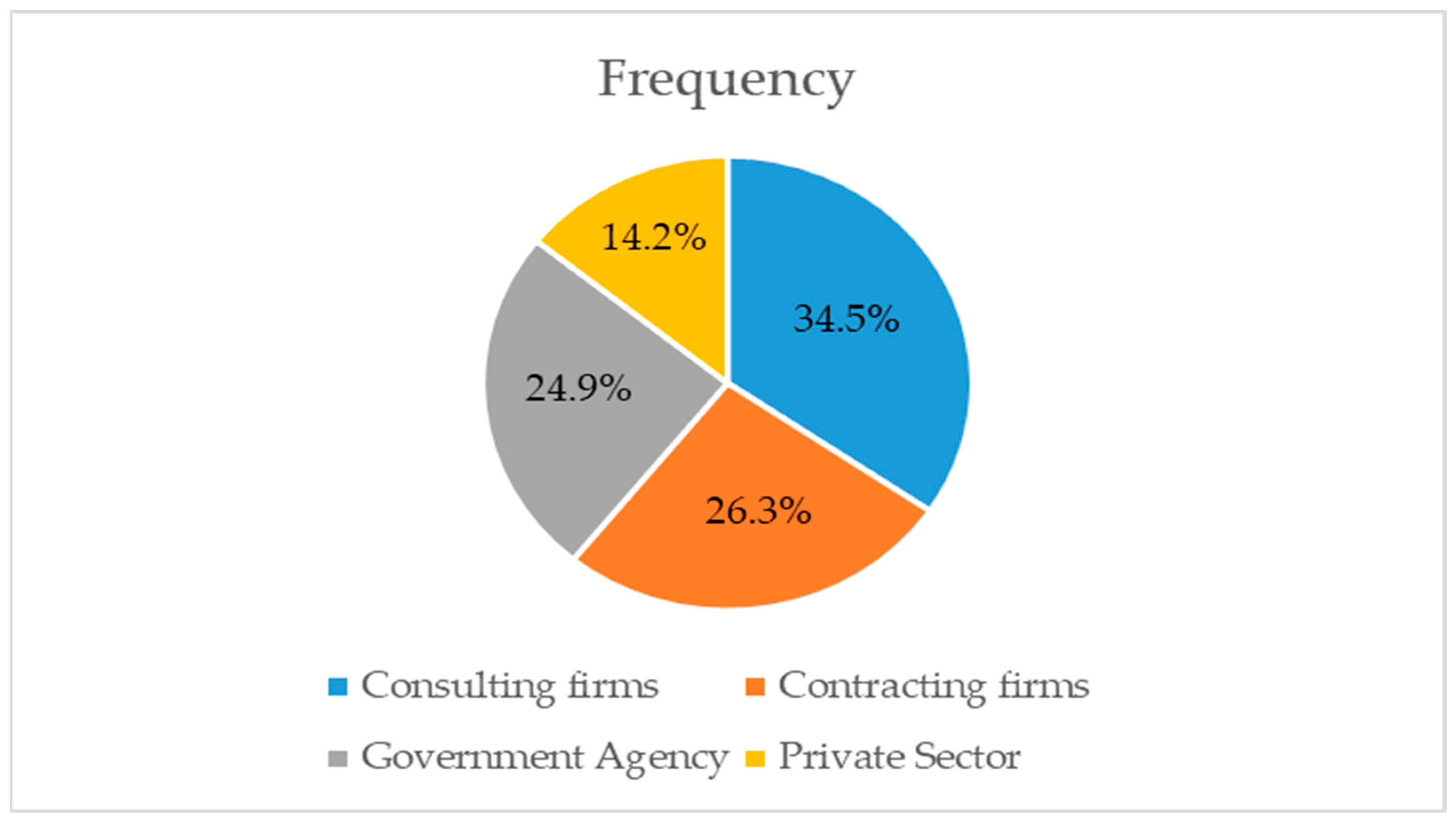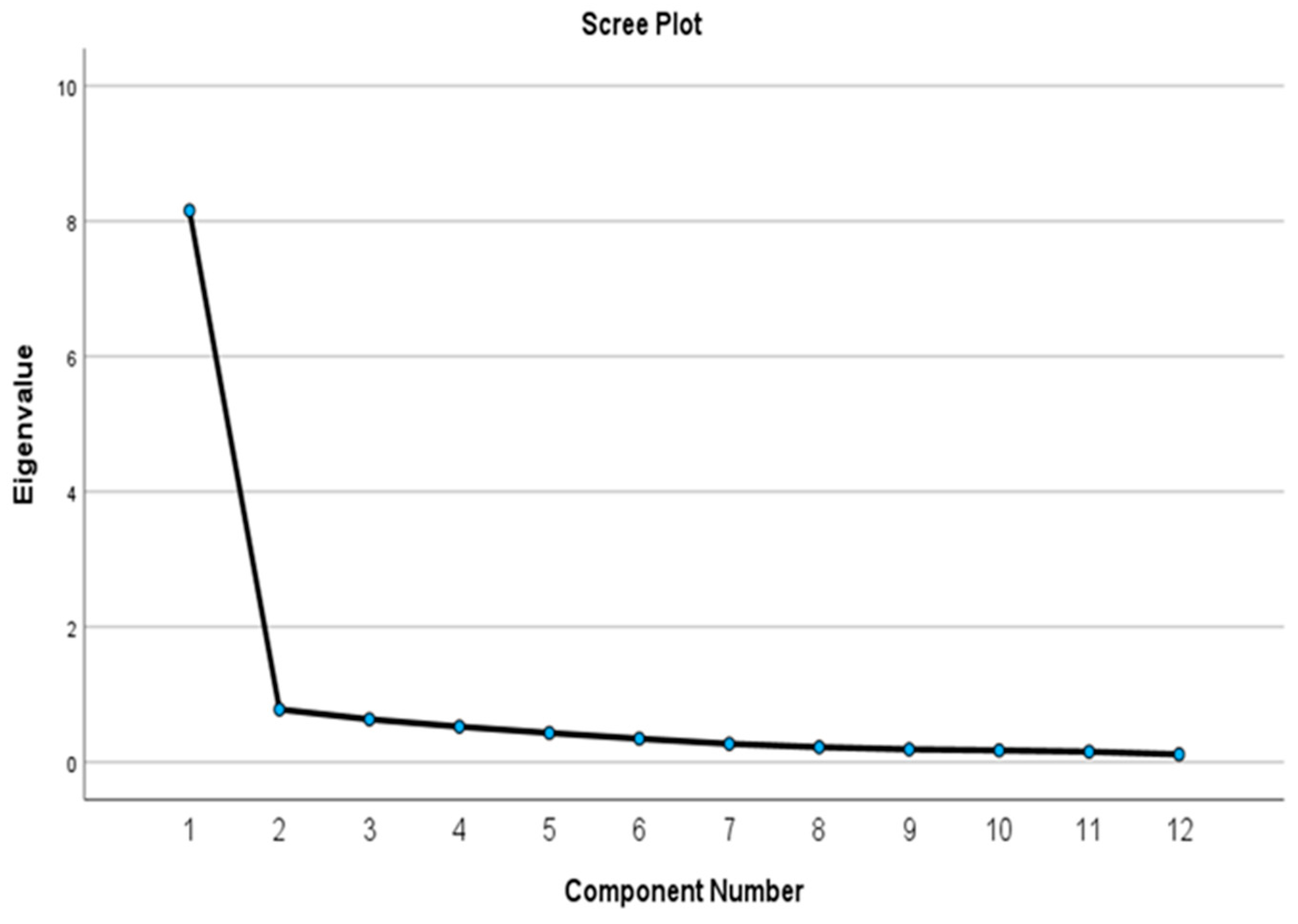1. Introduction
The productivity growth of the construction industry (CI) is lagging when compared to other sectors, requiring a sound knowledge sharing on contemporary and innovative approaches if the performance gap is to be closed [
1,
2,
3]. CI is fraught with conventional approaches which has negatively affected economies, human health, the environment, and the climate [
4,
5]. It contributes over 34% of CO
2 emissions and more than 32% of the world’s energy depletion [
6]. Predominantly utilised materials like steel and cement are a major source of construction waste and account for 18% of world emissions [
6]. Besides, approximately half of the world’s raw materials are consumed by CI [
5].
However, there has been a paradigm change in the CI due to the introduction of sustainability concepts [
7]. In the 21st century, it is well acknowledged that CI may improve its operations in the areas of the economy, society, and environment by implementing sustainable building construction (SBC) [
5]. SBC is defined as the “construction of buildings in a sustainable and green way” [
8,
9]. It is constructing structures to lessen their adverse effects on the environment while ensuring that social and economic goals are met [
10,
11].
Nevertheless, the construction of sustainable buildings requires a greater level of complexity compared to standard or conventional buildings [
7]. This is because a larger number of project participants and stakeholders are typically involved. This complexity necessitates expertise in handling design and construction. It also necessitates effective communication and knowledge to improve collaboration and integration among the different stakeholders [
12]. Similarly, handling the intricate ecological optimisation problems calls for a high degree of skill [
7].
Several hindrances to the adoption of SBC exist, especially in emerging economies. These include a decline in the use of technology, issues with safety and quality, and often intense political and socioeconomic constraints that impact the sustainability and execution of projects [
13]. One of the main forces behind Africa’s socioeconomic sustainability is the South African construction industry (SACI) [
13]. SA has higher standards for green building uptake than other African countries [
5,
9]. Nevertheless, compared to developed countries, SBC deployment is still lagging [
9,
14]. Among the major challenges are the inability to abandon conventional building methods [
15] and the dearth of consumer demand for sustainable products or structures [
16]. Likewise, the problems include financial obstacles, a lack of professional knowledge, public ignorance of sustainable principles, and non-compliance with SBC-related policies [
5,
17,
18]. Additionally, recording and transferring information from one construction lifecycle stage to the next has been challenging in SACI and developing nations CI [
7,
13]. Due to this, a performance gap exists in designing and constructing sustainable buildings [
7]. Also, substantial knowledge has been lost in the process [
7,
19].
Knowledge sharing and retention are challenges for the industry [
13]. An understanding of the effects of SBC should transcend organisational borders rather than being exclusive to CI [
20]. Knowledge sharing has been identified to have a significant impact on organisational performance, innovative culture and long-term sustainable competitive advantage and so on [
21]. Based on this notion, this study examines ways to improve SBC adoption through knowledge sharing.
While some studies relating to SBC knowledge sharing exist globally [
7,
21,
22,
23,
24], this research focuses on key knowledge-sharing features for spreading and facilitating the adoption of SBC in SA. A related study in construction is that of [
13]. However, ref. [
13] investigated the “barriers to knowledge management beyond organisational boundaries in SACI”. Thus, this study’s area of focus is novel and has not been investigated in SA. Therefore, using a quantitative approach with a principal component analysis technique, this study depicted the principal KSF for SBC deployment in SA. The revelation of the principal KSF will assist in bridging the performance gap and promote an awareness of sustainable building practices to create a sustainable built environment. The information offered will also assist decision-makers and construction practitioners in honing their tactics and knowledge exchange, which will boost overall performance among construction companies.
3. Methods
Figure 1 shows the methodological steps followed in this study. This study examined the Knowledge Sharing Features (KSF) for effectively adopting SBC in SA. The variables that most closely matched the study’s goals were taken from a review of previous research. The study employed a quantitative method utilising a structured questionnaire. The questionnaire was categorised into two parts. Part A included background information about the participants. Part B, on the other hand, included the KSF with questions using a “5-point Likert scale” with 1 for “no extent”, 2 for “low extent”, 3 for “moderate extent”, 4 for “high extent”, and 5 for “very high extent”. A 5-point Likert scale was used because of its capacity to improve validity and dependability and reduce response bias [
81]. Likewise, neutral midpoints allowed participants to express moderate opinions rather than being pressured into making extreme decisions [
82]. The responders were asked, “To what extent does each KSF influence SBC implementation?”.
Table 1 lists the variables used in the questionnaire and the literature references.
Before the final formulation of the questionnaire, a pilot study was conducted among ten academic respondents with experience in construction. Uncertain questions and confusing language that could make it difficult for respondents to answer the questions were resolved and adjusted with the help of the pilot test, which also helped to examine the selected factors [
83]. Likewise, following content validation of the measuring instrument, the authors received an ethical clearance certificate from the University of Johannesburg. The participants’ agreement to participate in the research was obtained, and voluntary participation was emphasised.
The study started with a random sampling technique but eventually switched to convenience sampling due to difficulty and impracticality in obtaining responses from participants across SA within the study’s time frame. Firstly, the questionnaire was circulated to the built environment professional bodies across SA, like the “South African Council for the Project and Construction Management Profession (SACPCMP)”, the “South African Council for the Quantity Surveying Profession (SACQSP)” and so on. However, due to the limited responses, the study was predominantly conducted in Gauteng province using a Convenience sampling technique. With the convenience sampling technique, the field study achieved a 70% response rate out of 400 circulated questionnaires. According to [
84], this strategy is advantageous when researching populations that are difficult to access or when resources and time are scarce. Additionally, it is helpful when randomising is difficult [
85]. Likewise, according to [
61], convenience sampling can be used to create objectives and hypotheses for use in more comprehensive research. Thus, this sampling strategy was selected because the information was acquired using respondents’ perceptions, and the researchers sought to develop hypotheses that might be further investigated in subsequent studies [
84,
86].
Although convenience sampling has been criticised for bias, this study took a few steps to tackle the issues of generalisability and prejudice. Firstly, the researchers made sure that participants who were competent or experienced answered the surveys. Additionally, the respondents admitted that they understood the topic and the information on the questionnaire. Professionals with backgrounds in “project management”, “construction management”, “civil, electrical, and mechanical engineering”, “quantity surveying”, “architecture”, and “town and regional/urban planning” were among those who responded. Also, the selection of Gauteng province helped generalisability. Gauteng was chosen because it is home to many building operations and has about 333,000 construction experts [
5,
87]. Major cities like Johannesburg and Pretoria are in Gauteng. With more than 33.9% of the GDP coming from it, it is the economic hub and engine of the country [
11,
88].
On another note, this study’s sample size of 281 was ideal, more than sufficient for the analysis, and less likely to produce unfavourable results [
88]. Moreover, the researchers dispersed the questionnaire over several domains and locations at various times to obtain a representative sample of the target population [
86]. Google Forms and emails were used for the electronic distribution of the survey. A Cronbach’s alpha reliability test was employed on the questionnaire measuring variables, and was found suitable.
The analysis used the “Statistical Package for Social Sciences (SPSS) software version 29”. Four-stage data analysis was adopted, like [
15]. However, the procedure, as shown in
Figure 1, was altered to meet the study’s goals. The Shapiro–Wilk test, presented in
Table 2, was used to determine if the data at the first stage were regularly distributed. Cronbach’s alpha was also used to evaluate the questionnaire’s reliability. Reliability improves as the value increases between 0 and 1 [
88]. As a result, the study’s measuring variables obtained an alpha value of 0.956, demonstrating dependability/reliability. The discovered KSFs were ranked in the second stage according to the respondents’ perceived relevance level using the mean item score (MIS). This was carried out concurrently with the KSF standard deviation calculation. According to [
89,
90,
91], the mean is a robust technique that can be used to make assumptions even in non-parametric tests, mainly where Likert-type data is used and the sample size is more than sufficient for the analysis. Similarly, ref. [
90] affirmed that parametric and non-parametric methods often yield similar results with large sample sizes and similar distributions.
In the third stage, the statistically significant difference in the participants’ responses according to their organisational sectors was ascertained using a non-parametric test (Kruskal–Wallis H-test). Likewise, the fourth stage captures PCA, which aided in emphasising the structure of the relationships between each variable and the respondents and reduced the datasets of KSF into components [
92]. The PCA captures the highest possible variance in the data and reveals underlying patterns and relationships [
88].
4. Results
4.1. Demographics
Figure 2 shows the study participants’ educational background.
Figure 2 portrays that many responses came from participants with “Honours/B.Tech degrees”, “Master’s degrees”, and “Bachelor’s degrees”. However, those with “National diploma” and “Doctorate” were ranked lowest. The findings show that the respondents are academically qualified to answer the survey.
Likewise,
Figure 3 reveals the participants’ professions.
Figure 3 shows that the ranking of the professions from top to lowest includes “construction management”, “engineering”, “quantity surveying”, “project management”, “architecture”, “town and urban/regional planning” and “Other”. These results indicate that the study’s conclusions might most apply to the engineering and construction sector rather than architecture and urban planning in the built environment.
Also,
Figure 4 demonstrates that many of the replies were from sectors like consulting, contracting, and government agencies. Hence, respondents from the “private sector” were minimal. These findings confirm that consulting, contracting, and the public sector consistently outperform the client/private sector regarding sustainability responses. These results correspond with [
93], who found comparable outcomes for the organisational category.
Figure 5 further portrays the demographics concerning the respondents’ industrial experience. Those with “6 to 10 years”, “1 to 5 years”, “11 to 15 years”, and “16 to 20 years” were the top four ranked. On the other hand, “less than 12 months” and “more than 30 years” were the penultimate and lowest ranked. The findings confirm that the respondents have the requisite experience and are qualified to participate in the study.
4.2. Descriptive Statistics of KSF
Table 2 indicates the descriptive analysis results of KSF for SBC deployment.
Table 2 demonstrates that all the variables had mean (M) values between 4.09 and 4.38. According to [
94], this shows the statistical significance of every variable at the 3.0 mean level in a five-point Likert Scale.
However, among the top five variables rated were the “mentoring younger professionals in sustainable practices” (M = 4.38), “public awareness of environmental issues” (M = 4.38), “raising awareness of green building goods/products” (M = 4.30), “staff training on sustainable practices” (M = 4.28), and “educational and training programs upgrade” (M = 4.27).
Likewise, the mean responses from organisational sectors were compared. The top five ranked variables from consulting firms included “mentoring younger professionals in sustainable practices”, “staff training on sustainable practices”, “public awareness of environmental issues”, “SBC integration in professional certifications”, and “raising awareness of green building products”. Similarly, from contracting firms, the five rated variables were “mentoring younger professionals in sustainable practices”, “public awareness of environmental issues”, “Information hub or repository for sustainable construction”, “awareness creation of green building products”, and “SBC integration in professional certifications”. For government agencies, the top-rated include “mentoring younger professionals in sustainable practices”, “educational and training programs upgrade”, “public awareness of environmental issues”, “education on sustainable practices among staff”, and “sustainable building materials awareness creation”. For, private sector, the top-rated included “public awareness of environmental issues”, “raising awareness of green building products”, “educational and training programs upgrade”, “staff training on sustainable practices”, and “creating public awareness for sustainable practices”.
Additionally,
Table 3 shows that the average mean value for all responders is 4.22. Similarly, regarding “consulting firm”, “contracting firm”, “government agencies”, and “private sector”, the average means are 4.24, 4.27, 4.18, and 4.15, respectively. Similarly, based on the respondents’ organisational sectors, the K-W H-test showcased a significant difference in respondents’ perceptions of the variable “mentoring younger professionals in sustainable practices” (
p-value 0.047 @0.05 threshold). Additionally, the internal consistency of the measurement variables and the high reliability of the study instrument are depicted by the Cronbach’s alpha value of 0.956.
4.3. PCA for KSF
PCA captured the highest possible variance in the data and revealed the underlying patterns and relationships within KSF that influence SBC. The factorability test revealed that the twelve variables were sufficient. The Kaiser-Meyer-Olkin (KMO) sample adequacy test result (0.930) was more than the 0.6 minimum required to proceed with factor analysis [
88], as shown in
Table 4. The 0.001 outcome of Bartlett’s test of sphericity further supported factorability. Additionally, the variables were rotated using the varimax rotation technique, and PCA was employed for the extraction procedure.
Table 5 indicates the total variance explained (TVE) and communalities results.
Table 5 reveals that one principal component factor achieved an eigenvalue above one (8.157), having a variance of 67.976 overall, above the 50% required criterion [
95]. The communalities result in
Table 5 indicate that all the extraction values above the 0.5 cutoff demonstrate the appropriateness of the data and the items’ goodness of fit within each component factor [
88]. Nevertheless, the scree plot in
Figure 6 substantiates the extraction of one component factor. It shows a considerable gap after the first component factor, after which the remaining components with eigenvalues less than one gradually wander off.
Likewise,
Table 6 presents the component matrix results, which also categorise the factor loadings of the KSF variables in the extracted component in their order of importance. The extracted component was named Green Education Initiative and Eco-Awareness Alliance. This name was supported by [
96,
97], who affirmed that raising environmental consciousness among all people boosts overall production, lowers costs, and increases employee productivity and efficiency, as well as sustainability.
As shown in
Table 6, this comprised “creating public raise environmental awareness for sustainable practices” (0.882), “content of SBC training” (0.872), “raising awareness of GBPs” (0.851), “SBC integration in professional certifications” (0.844), “Information hub or repository for sustainable construction” (0.836), “mentoring younger professionals in sustainable practices” (0.830), “sustainable building materials awareness creation” (0.827), “educational and training programs upgrade” (0.813), “cooperation with international companies for transference of knowledge” (0.801), “using research to promote local GBPs” (0.796), “awareness of environmental issues among the public” (0.770), and “staff training on sustainable practices” (0.764).
5. Discussion
The results of
Table 2’s descriptive statistics showed that critical knowledge sharing features (KSF) to deploy SBC effectively included “mentoring younger professionals in sustainable practices”, “public awareness of environmental issues”, “raising awareness of GBPs”, “staff training on sustainable practices”, and “educational and training programs upgrade”. Out of the twelve variables, these were the top five, respectively. Nevertheless, the mean results of the twelve variables which exceed the 3.0 threshold indicate that all the variables are significant [
94]. This implies that they all correspond with the hypothesis that they are critical for advancing SBC in SA.
The findings about “mentoring younger professionals in sustainable practices” and “public awareness of environmental issues”, which were both ranked first, strongly support the study’s hypothesis. Mentoring younger professionals is crucial to instilling long-term environmental responsibility across construction firms [
42]. Similarly, the findings align with [
41], who suggested youth mentorship as a crucial strategic step in fostering social integrity and sustainability. The findings also corroborate those of [
43] in Finland, which highlights that mentoring is an essential part of sustainability, allowing past, present, and future phenomena related to work life to be addressed. The study [
43] also emphasised the need for sound leadership through mentoring for tackling sustainability issues. Experienced professionals can teach the upcoming generation the required advanced skills and viewpoints through mentorship [
44]. Also, the results concerning “public awareness of environmental issues” are consistent with [
64,
65]. In China, ref. [
65] emphasised the criticality of making the public aware of environmental issues and the need to invest in sustainable/green buildings. Likewise, ref. [
64] discovered that the shift to green building in the USA was greatly aided by the public’s increased knowledge of environmental issues.
The findings on “awareness creation of green building products” are consistent with those of [
61,
63], who confirmed that this is a key strategy for enhancing green building in developing nations. On the other hand, the finding regarding “education on sustainable practices among staff” as a key component is consistent with [
63]. The details of these GBPs should be made public, and the desire to go green may be greatly aided by awareness of these products [
63].
Besides, the findings on “educational and training programs upgrade” support the assertion made by [
49,
59]. According to [
59], one of the primary obstacles to sustainable construction is the scarcity of adequate educational programs at the high school and college levels that promote green building practices. Similarly, ref. [
59] suggests that the primary means of encouraging and implementing sustainable construction practices is likely education and training in sustainable construction concepts and techniques.
Furthermore, the PCA results confirmed “Green Education Initiative and Eco-Awareness Alliance” as the principal component for advancing SBC in SA. The findings also corroborate [
94], who posit that to solve problems like resource scarcity, climate change, and environmental degradation, education for sustainable development (ESD) gives people the attitudes, information, and abilities they need to encourage sustainable behaviours. Consequently, this principal component revealed that
creating public awareness for sustainable practices is a top factor. This indicates that raising awareness is vital to accelerating SBC adoption at all societal levels, from legislators to developers and homeowners in SA [
3,
20]. Similarly, the component revealed the
content of sustainable building construction training as key to ensuring that SBC is advanced and implemented in SA. This suggests that the contents of training should accommodate current trends and best practices [
2]. The finding regarding the
awareness creation of green building products in this component further solidifies the necessity of advertising these products and their benefits as opposed to conventional approaches [
63]. Furthermore, SBC integration in professional certifications was crucial for this component. This confirms that incorporating technical competence on sustainable building principles within professional development criteria can improve the adoption of sustainable practices [
50].
General Practical Implications and Recommendations of the Study
This study’s useful implications stem from its ability to provide policymakers and stakeholders with the knowledge of the critical KSF they need to effectively steer reform initiatives. The study recommends special emphasis on sustainability education and awareness among construction practitioners and the public. This may be achieved through workshops, online training courses, frequent sustainability communications (emails and newsletters, etc.), and interactive initiatives like sustainability champions or green teams and so on. Public awareness of sustainability practices and green products can also be enhanced through partnerships with local companies, educational institutions and non-governmental organisations to spread the message and reach various audiences. In other words, a public-private partnership is highly recommended. To co-develop and deliver training, the Green Building Council South Africa (GBCSA), academic institutions, and construction companies must work together.
The study suggests mandating SBC competencies in built environment certificates. For instance, requiring sustainable construction content in SACPCMP, the Engineering Council of South Africa (ECSA) and the CIDB registration framework. SBC integration into professional certifications will accelerate the green transition as it will guarantee a trained workforce that can meet green/sustainable building regulations and national climate targets. For example, the Department of Public Works Green Building Policy Framework and the National Climate Change Response Strategy necessitate skilled professionals in SBC to support implementation [
98,
99]. Therefore, if the adoption of SBC will accelerate in SA, the government should demand SBC-Certified professionals for public infrastructure and housing projects. This will enable Reconstruction and Development Programme (RDP) housing upgrades in SA, aligning with sustainable development agendas. Besides, hiring experts with SBC certification among construction organisations will improve construction quality, increase client trust, and improve the company’s reputation.
Likewise, the study emphasised the vitality of the quality of content for SBC training. The foundation of SBC training rests on high-quality information. Training that includes real-world case studies, simulations, and local project data will help learners translate theory into practice. Key features like sustainable resource use, waste minimisation, and eco-friendly materials and so on must be embedded in training content to foster practical competence [
9]. Quality content will assist learners to not only comprehend the concepts but also prepare them to apply them sensibly and practically. Additionally, reliable and consistent information encourages industry standards, guaranteeing that procedures are accepted and understood universally. Additionally, quality training content necessitates that solutions are tailored for various climates, cultural norms, and economic situations.
The study also emphasised mentoring of younger professionals. SACI faces a shortage of skilled professionals, especially in sustainable practices. Construction firms should establish a structured mentorship program with environmental goals. Structured mentorship programs will assist in the transfer of critical knowledge from experienced professionals to emerging talent, ensuring continuity and innovation in green or sustainable building methods. A structured mentorship program will support industry transformation in SACI, which is fraught with youth unemployment at 45.5% [
100]. Therefore, mentoring younger professionals will foster career development, enhance practical competence, knowledge transfer and so on.
Additionally, “Cooperation with international companies for knowledge transfer” can lead to informed policy reform and innovation incentives to align with what works in global contexts. International firms may be required by policy to create local supply networks, form joint ventures and transfer technology. Collaboration for knowledge transfer will foster sustainable building and digital construction. It provides opportunities for creating centres of excellence with local universities, the Department of Higher Education and Training (DHET) and the Construction Industry Development Board (CIDB). Likewise, knowledge transfer provisions requiring foreign companies to agree to training, localisation, and local subcontractors should be incorporated into public procurement contracts. For the CI, this knowledge-sharing feature fosters access to advanced construction technologies and workforce upskilling, enhances quality and safety standards, and can increase project efficiency and competitiveness.
Moreover, the findings regarding the principal component/cluster “Green Education Initiative and Eco-Awareness Alliance” will contribute to improving skill development and workforce readiness. Implementing sustainable practices is easier for a workforce that has received training from the Green Education Initiative [
96]. This emphasises how crucial it is for corporations, civil society organisations, legislators, and educators to work together to overcome obstacles, including inflexible curricula, opposition to change, and unequal financing and resources. Similarly, eco-awareness alliance campaigns will promote more rigorous compliance with environmental regulations and guidelines such as the National Environmental Management Act (NEMA) regulations, environmental impact assessments (EIAs) and so on [
5]. Furthermore, adherence to the principal component will enhance the construction companies’ public image and sustainability credentials. For instance, green certifications can become a selling point, attracting eco-conscious investors and clients. It will also align with national and international green goals like SA’s Just Transition Framework and SDGs [
101]. Finally, it can lead to cultural and behavioural change, causing a shift from a temporary gain mindset to long-term sustainability.
6. Conclusions
This study assessed the KSF for deploying SBC. Twelve variables most relevant to SA were identified from the extant literature. These variables were evaluated with a four-stage data analysis methodology, which comprised “validation and reliability of the research instrument”, “mean ranking”, “Kruskal–Wallis H-test”, and PCA. Based on the findings of the study, the following observations were noted.
- •
Every variable met the required reliability standards and underwent validation. Given that the mean item scores in a 5-point rating were high (above 4.00), the results demonstrated the importance of every feature.
- •
The results show that the consulting sector has advanced in awareness compared to other sectors, especially the public and private sectors. Thus, the study suggests prioritising awareness creation in these sectors to facilitate adoption in SA.
- •
The key KSF for deploying SBC in South Africa have not been examined in any research. It is also one of the more recent studies carried out in SA that clarifies the components required for the successful deployment of SBC.
- •
PCA was used to extract a key component/cluster, the Green Education Initiative and Eco-Awareness Alliance. This cluster disclosed crucial features like “creating public awareness for sustainable practices”, “content of SBC training, raising awareness of GBPs”, “SBC integration in professional certifications”, “mentoring younger professionals in sustainable practices” and so on. Consequently, this research contributes to the body of knowledge. This research, therefore, confirms the Green Education Initiative and the Eco-Awareness Alliance as a key cluster that will propel SA’s adoption of SBC.
- •
This study fosters and recommends the collaboration of CI practitioners, government, educational institutions and NGOs in advocating for knowledge sharing of SBC initiatives in SA. To assist construction stakeholders in promoting knowledge sharing for a sustainable built environment, it is advised to carefully consider the key knowledge sharing characteristics identified in this study.
The study has some Limitations. The research was constrained to Gauteng, South Africa. As a result, the results might not apply to other parts of the nation or to developing nations. Additional research involving data from several SA provinces might be conducted for a more complete picture, improving the findings’ generalisability. Nevertheless, because the knowledge sharing challenges are the same for most African developing countries, there is a good indication that the findings may benefit other developing nations. Besides, the study’s results can best be applied to the engineering and construction sector, which had the greatest respondents in the survey. Similarly, the use of convenience sampling, considering the difficulty in the availability and accessibility of the required professionals, may suggest some bias in representation. Hence, future studies with other sampling techniques, like stratified and random sampling, are recommended. Furthermore, future studies using “confirmatory factor analysis”, “structural equation modelling or path analysis” are recommended. Nevertheless, the authors want to close this gap in future research.
